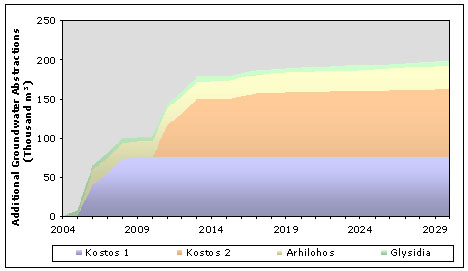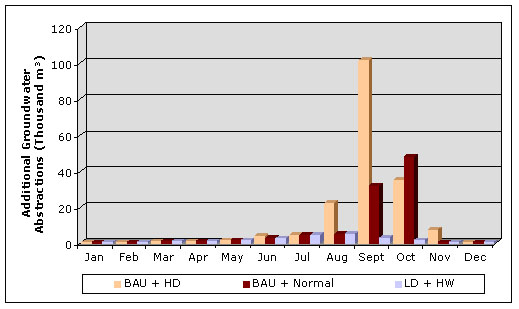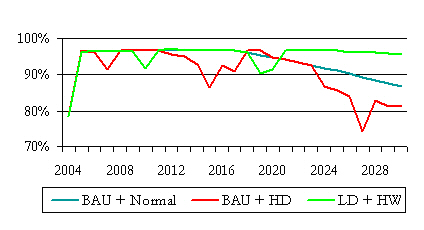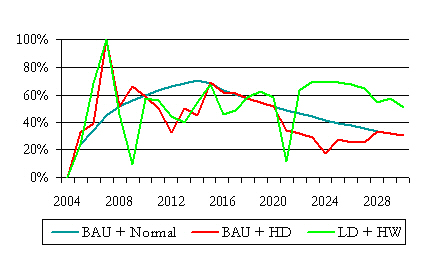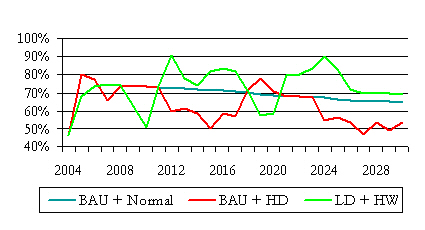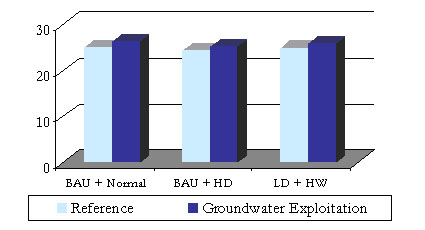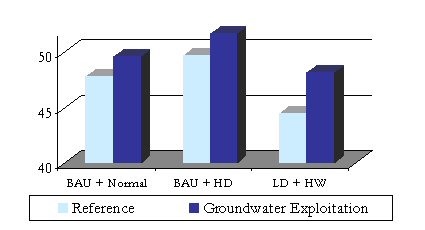
ISSUE 6 |
||||||||||||||||||||||||||||||||||||||||||||||||||||
|
|
|||||||||||||||||||||||||||||||||||||||||||||||||||
Option details and results |
||||||||||||||||||||||||||||||||||||||||||||||||||||
|
The yields and costs of the proposed interventions are summarized in Table 1. |
||||||||||||||||||||||||||||||||||||||||||||||||||||
|
Table 1. Yield and construction costs for new boreholes
Figure 1 presents quantities abstracted from the new drillings for the BAU+Normal scenario. The month variation of water production for a normal, dry and wet year (2009 under the three scenarios) is presented in Figure 2. Figure 1. Additional Groundwater Abstractions (BAU+Normal scenario) The new boreholes are assigned a very low supply priority with respect to existing supply sources. For this reason, under all three scenarios the new boreholes operate after the peak summer months, when the traditional supply sources have been depleted. During the peak season, supply normally originates from the existing groundwater drillings. Figure 2. Monthly variation of abstractions from the new boreholes (2009) |
||||||||||||||||||||||||||||||||||||||||||||||||||||
Effectiveness |
||||||||||||||||||||||||||||||||||||||||||||||||||||
|
The coverage of Domestic demand shows some improvement where the option is applied, which is once again diminished as the demand grows over time (Figure 3). Although the traditional practice of groundwater exploitation can assist in meeting some domestic requirements, this effect is almost diminished in cases of drought, as it is depicted from the results of the BAU+HD scenario (Figure 4). Figure 3. Percent demand coverage effectiveness of Groundwater exploitation to Domestic use Figure 4. Percent Improvement of deficit in Domestic use with respect to the reference scenarios In general, irrigation deficits are not significantly affected, with the exception of the high dry scenario (Figures 5 and 6). Figure 5. Percent demand coverage effectiveness of Groundwater exploitation to Irrigation use
|
||||||||||||||||||||||||||||||||||||||||||||||||||||
Direct and Environmental Costs |
||||||||||||||||||||||||||||||||||||||||||||||||||||
|
Overall the direct cost increases are similar to those of the network unification option. A small average increase of about 3.5-5% is common among all three scenarios. Infrastructure construction costs are low; the increase is due to the augmentation of water abstracted and delivered to domestic use, which incurs a proportional increase in annual operating costs
Figure 7. Total direct cost difference of the Groundwater exploitation option under the three scenarios (Present Value – Million €) The total environmental cost records a substantial increase due to the increase of groundwater abstractions. In all cases, it is considerably higher than the respective reference case, with the highest values recorded for the high dry scenario (Figure 8).
Figure 8. Total environmental cost difference of the Groundwater exploitation option under the three scenarios (Present Value – Million €) |
||||||||||||||||||||||||||||||||||||||||||||||||||||
